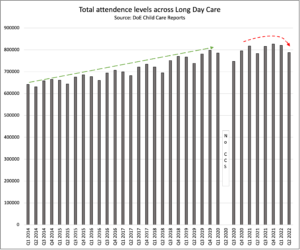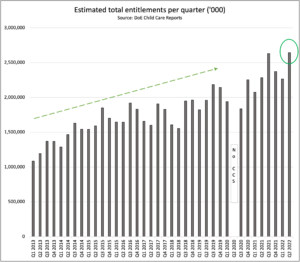LDC attendance rolls over despite CCS boost according to latest DoE Child Care in Australia report

The number of children attending a long day care (LDC) service recorded a 4.0 per cent drop despite a 16.7 per cent increase in total entitlements disbursed in the form of Child Care Subsidy according to the latest release of the Department of Education’s Child Care in Australia report.
The report, which is released quarterly but with a nine month time lag, provides a valuable snapshot of key early childhood education and care (ECEC) sector data drawn from CCS administrative systems.
Of particular note in this most recent release is the ongoing drop in attendance momentum in LDC settings. 787,500 children attended an LDC service in the June quarter of last year, which is down 4.0 per cent from the March quarter and up just 0.6 per cent on the same period in 2021.

Although the June quarter is a seasonally low attendance quarter historically,(ie: pre-COVID,) each successive June period was met with a relatively meaningful increase in attendance, a trend which appears to be in jeopardy.
A key driver of this is likely to be affordability, and factors associated with availability of subsidy hour caps being achieved, which both will impact families enrolment decisions.
From a fee perspective the percentage of services now charging more than the CCS fee cap reached a new record across all settings in the quarter with 21 per cent of LDC services charging more than the cap, the sixth consecutive increase.

The trend is even more pronounced in family day care (FDC) settings which now have over 40 per cent of services charging more than the fee cap rate.
The fee cap was embedded in the CCS legislation as a mechanism designed to dis-incentivise providers from raising fees too quickly as every dollar increase above the cap would not receive the benefit of subsidy entitlements and therefore lead to higher out of pocket costs for families.
The data suggests that the initial intentions of the fee cap mechanism are failing to be met, and that an increasingly large proportion of families will be incurring families in excess of the CCS fee cap levels.
Against that backdrop of lower demand and higher out of pocket expenses total entitlements in the form of CCS disbursed in the second quarter of 2022 reached a new record as pre-election CCS changes came into effect with LDC attracting $2.09 billion, of the total $2.64 billion.

Although these data series are lagging indicators, the trends they illustrate will be closely watched by the Federal Government, the Productivity Commission and the ACCC, all of which are working on ECEC related initiatives.
In addition, the lack of an additional demand response by families in LDC services after the passing of an entitlement increase, albeit relatively narrow, will be of particular interest as the implementation of the Cheaper Child Care Bill affordability measures commence on 1 July 2023 with its intent to boost usage come into view.
Popular

Policy
Practice
Provider
Quality
NSW Government launches sweeping reforms to improve safety and transparency in early learning
2025-06-30 10:02:40
by Fiona Alston

Quality
Provider
Policy
Practice
WA approved provider fined $45,000 over bush excursion incident
2025-07-01 07:00:01
by Fiona Alston

Workforce
Policy
Quality
Practice
Provider
Research
ECEC must change now, our children can’t wait for another inquiry
2025-07-02 07:47:14
by Fiona Alston











